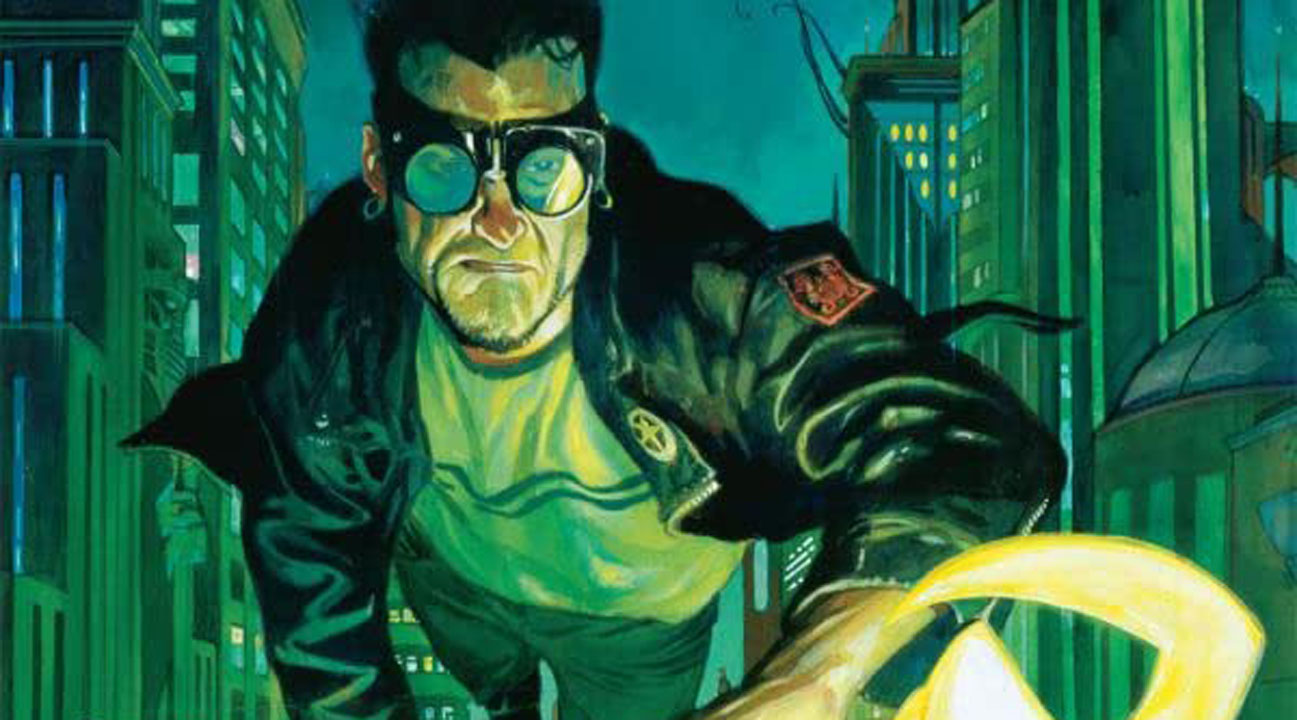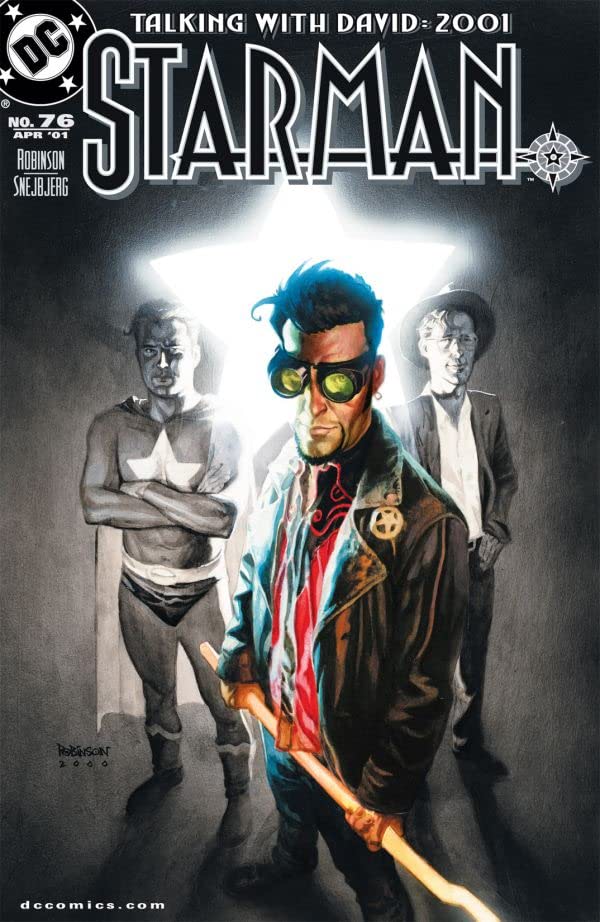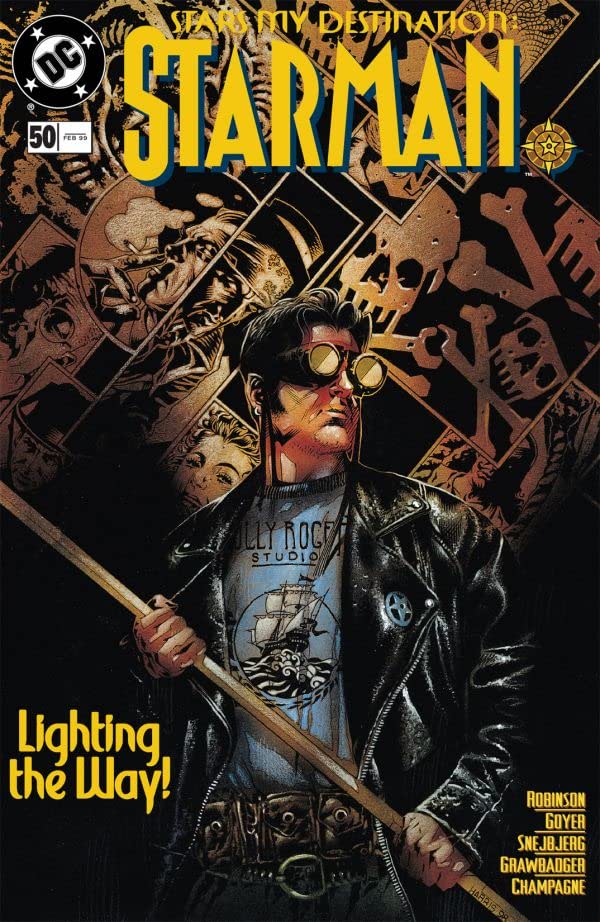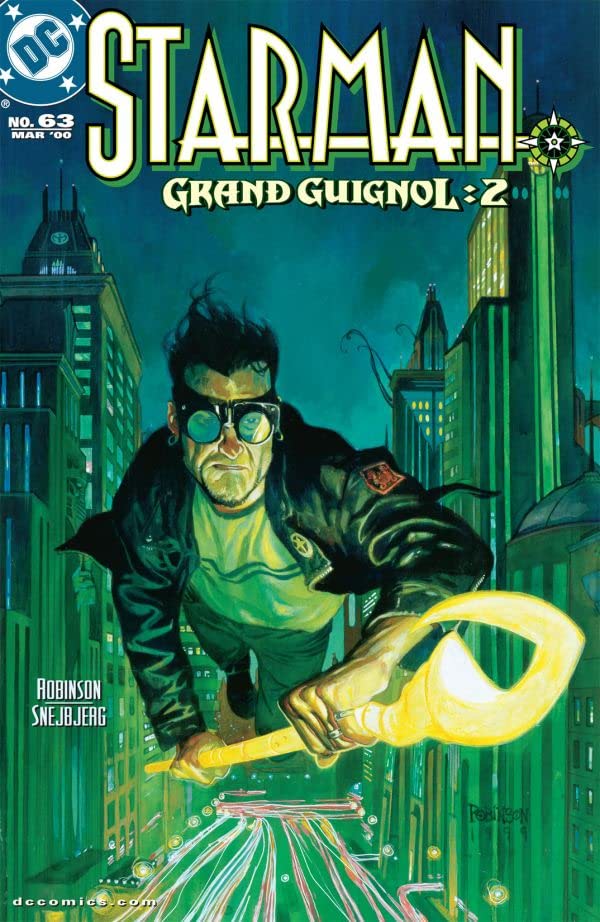Starman: the most acclaimed DC series you may never have read
If you missed Starman, it's time to go back and find it. If you've been with Starman all along, it's time to re-read it, enjoy it, and get wrapped up in it all over again

We come not to bury Starman, but to praise him.
That, and to rip off some Shakespeare while we're at it.

For seven years, James Robinson was the guiding force behind one of DC's quietest - and highest quality comic series; a superhero book without the superhero trappings, Starman.
Rising from the fallout of the Zero Hour event in 1994, Starman was the only survivor of three totally new series that started as a result of Zero Hour, which also included Primal Force and Manhunter. While the other series had their pluses, Starman ultimately won out because it was… personal.
Working with artist/co-creator Tony Harris, writer James Robinson never made any bones about the fact that he had put a lot of himself into the character of Jack Knight. As Robinson matured and grew, so did Jack. As Jack cast off the trappings of being a somewhat obnoxious 20-something, and faced his 30s with more questions than answers, so did Robinson.
It was that intimate link which helped to make Starman special – with so much of a real person inside the character, Jack Knight felt more real than virtually all of his early '90s contemporaries, and still resonates with that realism. Jack is a three-dimensional character, with his own unique quirks, flaws, and hang-ups. Jack's individuality became such a part of the book that, just as in real life, sometimes readers found themselves disagreeing with his motives or actions. That was part of the draw – Jack sometimes made bad decisions.
Strength of Character

Early on in the series, given Jack's less than macho-man attitude and somewhat slighter appearance than the ever-buff spandex crowd, a line of reasoning made its way through fandom, suggesting that Jack was gay, or at least bisexual. It was something of a sad commentary given that it was built mainly on Jack's appearance and decidedly different view of things superheroic. As a superhero, Robinson's Jack Knight hearkened back to Grant Morrison's Animal Man – a physical confrontation was the last thing he wanted, and often, such as in issue #4, he found other ways to deal with potentially violent situations.
Get the best comic news, insights, opinions, analysis and more!
So yeah, being that he'd rather talk than fight, didn't have muscles on top of muscles, and didn't wear a costume, he had to be gay in the view of some. Luckily, that view of Jack faded over time, as the storylines made it a non-issue.
That's not to say that Jack couldn't, or wouldn't use violence if needed. While as Starman, Jack's weapon of choice was the Cosmic Rod created by his father Ted, Jack had martial arts training and wasn't afraid to fight.

Killing was another matter.
Jack killed enemies in the series twice, and each time, as he later revealed, it left him feeling sick at heart. "It felt like I'd murdered a piece of myself," Jack said in issue #76. It was more than Superman's "killing is wrong" stance, and again, helped to make Jack a real person – someone that was easier to relate to than your normal superhero.
Jack's normalcy placed him apart from the rest of the herd - in some ways, Jack Knight seemed like a visitor in the DC Universe – despite being the latest in a line of Starmen (a legacy, he learned, that would continue long past his ultimate retirement and death), he remained fresh and new to the superhero game, and could every now and then be caught up in the wonder of the moment as he met people that, to him, were legends – the 'grown-ups' that might just one day realize he's a kid playing hero.
Respect For One's Elders

Speaking of the other heroes, Starman was a series that always played well with others. Not just other currently-running series, but with virtually every series in the DCU ever. One of Robinson's initial challenges with the series, of course, was to tie together the three characters in the DCU other than the men with the surname Knight, who had been called Starman. Given that the three were from three very disparate eras (the funky blue-skinned, red-haired Starman from the '70s, the space-faring Starman from the early '80s, and Will Payton, the Starman from the late '80s), and seemed, at worst, to merely be characters created to maintain DC's hold on the copyright, Robinson wove all of their lives together seamlessly over the course of the series.
Throughout the seven year-run, Robinson treated continuity with care - not ignoring it or tweaking it mercilessly until it bled, but working to integrate it into his current storyline, cleaning and repairing only if necessary.
For example, Robinson explained the variations that the Solomon Grundy character has had over the years, tied the Western character of Scalphunter to the current DCU, returned the Shade to a place of prominence within the DCU, set up Wesley Dodds and Dian Belmont for a grand exit from the DCU, explained the relevance of the ghost of Jon Valor, made Copperhead and damn scary villain again, killed off a bunch of heroes from the Justice League Europe, and tied together loads of outer space concepts that were introduced from the '60s through the '80s. It was if Robinson was given the keys to play with all of the DC characters he read while growing up, and wove them all into a massive tapestry. And he was one hell of a weaver.

Helping Robinson tie together all of the past with the present were the 'Times Past' and 'Talking With David' issues, which showed a tale of Starmen or Opal City past and allowed Jack to spend an evening with his dead brother David, respectively. Each happened roughly once per year. The stories were gems for continuity buffs and poignant snippets that, along with the theme that's growing here, added to the series immeasurably.
One of the best throughlines of the entire series that ties the past to the present, of course, was Jack's relationship with his father, Ted Knight, the original Starman. The two began as near-opposites but grew to like, respect, and finally love one another. It was, up until its end – and even beyond, one of the most well-rounded father-son relationships in comics. Through Jack's relationship with Ted, the elder Starman became a fully fleshed-out character, rather than another suit from the '40s. Ted had ambitions, flaws, dreams, and hopes.

Resonating slightly throughout the Jack-Ted relationship were some of the relationships Robinson had with his mentor in comics, and original Starman editor, Archie Goodwin. Goodwin's death in 1998 hit Robinson hard, and for a time, he was unsure if he would be able to finish what he had begun in Starman. In a coincidental turn, Robinson's storyline that followed his eulogy for Goodwin was 'City Without Light,' and then 'Stars My Destination,' which sent Jack into the emptiness of space.
Robinson answered many of the questions posed earlier in the series in 'Stars My Destination,' but left many unanswered specifically for when Jack got home from his 12-issue jaunt into space.
Promises Kept

From the beginning of the series, Robinson knew the story he was going to tell would be a long one. Some questions first raised in the Shade's Journal seven years back are finally being answered in the final issues of the series, with poignant effect. The ghost pirate first seen in issue #7 played a major, major roll in the 12-part 'Grand Guignol' story arc. Villains avenged themselves, heroes revenged one another. Grudges were held, blood feuds spanned generations, and were ultimately resolved. Characters and events that troubled Ted Knight returned to threaten Jack. Characters grew, changed, and led fully rounded lives.
Perhaps one of the more... interesting... long-term developments that was a bold step at the time was the scene of Jack being raped in issue #12. He was raped by Nash (the daughter of the original Mist), and what she did to him there played a large role in the choices Jack makes at the end of the series.

Starman was like that – plot threads that were seemingly left dangling weren't really – Robinson had plans to come back and tie everything together, from casual comments made about the next Starman being Thom Kallor of the Legion of Super-Heroes to answering the questions about the Starman of 1951. It all fit together under Robinson's guidance.
Sure, to some, Starman was a little dense, but that's the way it was designed. Robinson was writing a series that embraced the notion of superheroes, their rich history within the context of the DCU, and one man's role within it. It's somewhat appropriate that as series are more and more often being pushed to four to six-part story arcs that can be easily collected as trades, Starman, with it's numerous eight- and twelve-part arcs, and seven-year-long continuity, steps down. In many respects, Starman was an 80-part series. Well, 81, counting the zero issue, er, 89, counting the two annuals, one special, a four-part Shade limited series, and a One Million issue. It all works together.
If you missed any of it, it's time to go back and find it. If you've been with Starman all along, it's time to re-read it, enjoy it, and get wrapped up in it all over again.
Matt Brady was the co-founder and managing editor of Newsarama until 2008. Since then, he’s moved back to science and teaches high school physics and chemistry. He’s also written a handful of comics, as well as The Science of Rick and Morty from Simon and Shuster. With his wife, Shari, he started thescienceof.org, which blends pop culture with science as a means to increase student engagement and the public’s interest in science.



